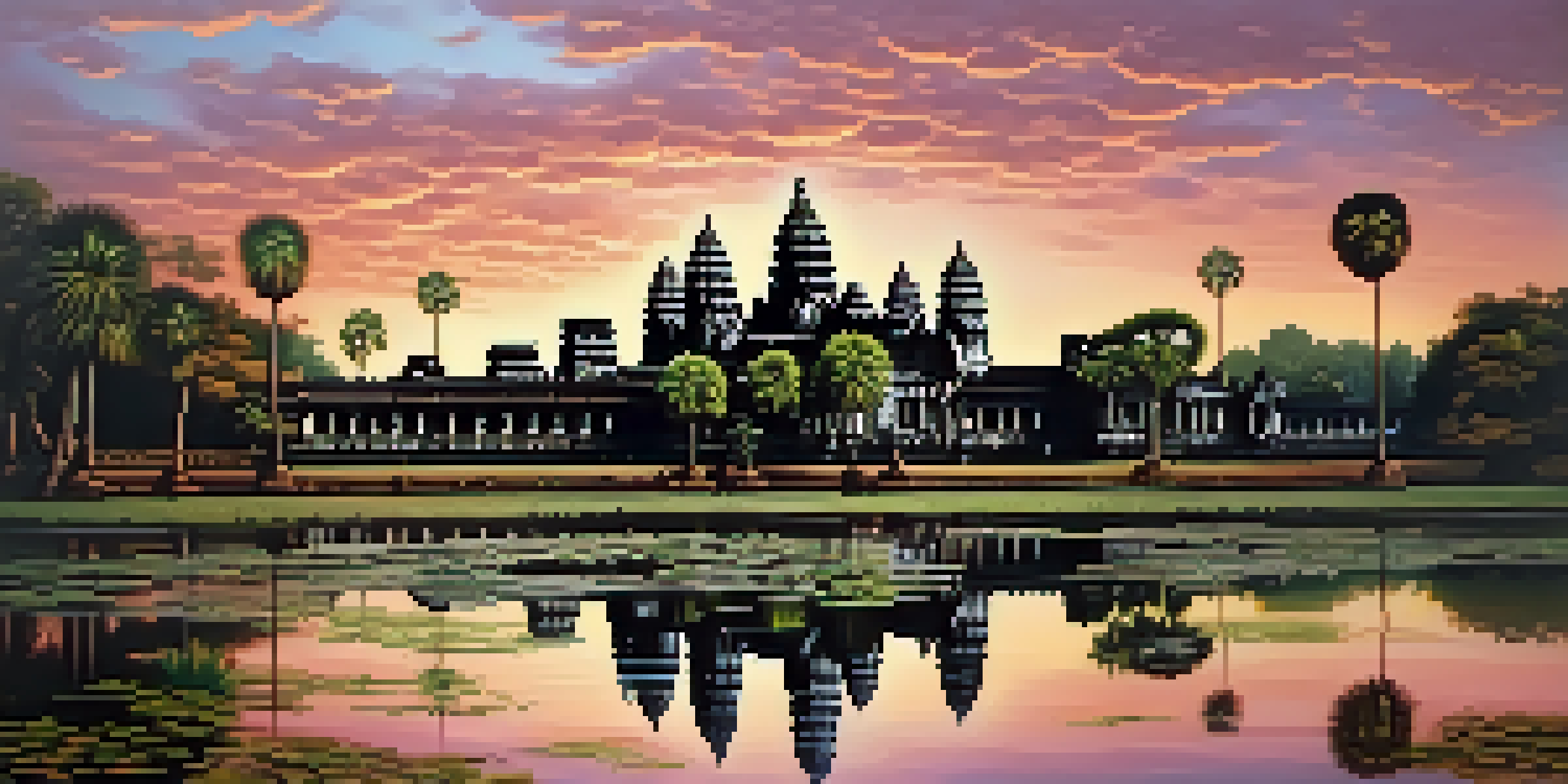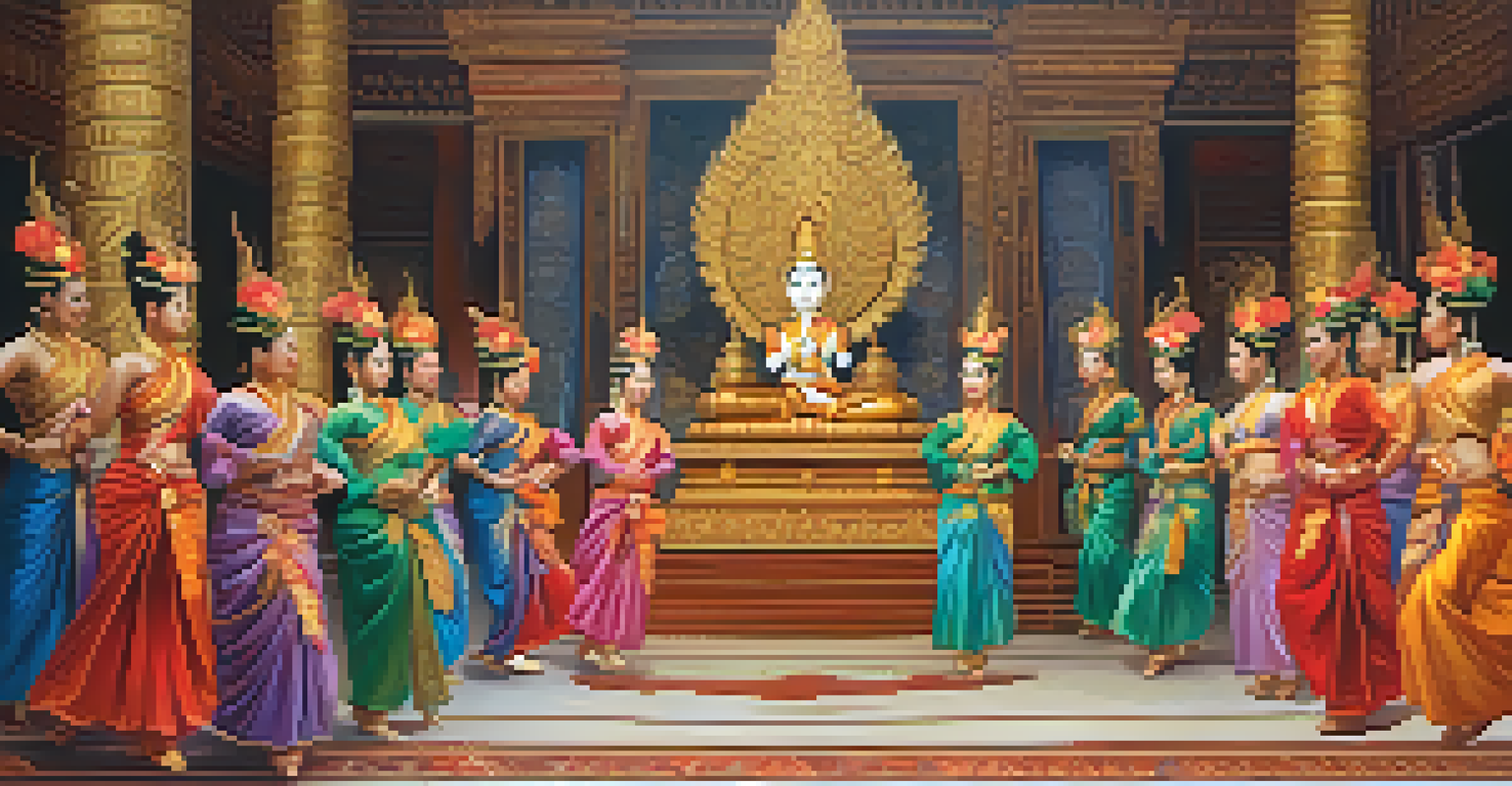The Impact of the Khmer Empire on Thai Kingdoms and Culture

The Rise of the Khmer Empire and Its Geography
The Khmer Empire, flourishing from the 9th to the 15th centuries, was centered in what is now Cambodia. This powerful civilization expanded its influence across Southeast Asia, including regions that would later become parts of Thailand. The empire's strategic location allowed it to control trade routes and cultural exchanges, which played a pivotal role in shaping neighboring societies.
History is a vast early warning system.
Geographically, the Khmer Empire was blessed with fertile lands, particularly around the Tonle Sap Lake and the Mekong River. This abundance supported agricultural advancements, which in turn supported the growth of cities and temples that marked the empire's architectural prowess. As the Khmer expanded, they brought their innovations in irrigation and agriculture to the Thai kingdoms, enhancing local economies.
The Khmer's geographical dominance meant that their culture, art, and politics had a lasting impact on the region. As they established trade networks, the exchange of ideas and goods flowed freely, cementing a legacy that would resonate in Thai culture for centuries.
Architectural Influence: Temples and Cities
One of the most visible impacts of the Khmer Empire on Thai kingdoms is found in architecture. The grandeur of Angkor Wat, the empire's most famous temple, served as an inspiration for many structures built in Thailand. Its intricate carvings and sophisticated layout influenced the design of temples such as Wat Phra Kaew in Bangkok, showcasing a blend of Khmer and Thai styles.

Khmer architectural techniques, including the use of laterite stone and extensive bas-reliefs, were adopted by Thai builders. This not only enriched Thai temple architecture but also led to the construction of monumental structures that reflected religious beliefs and the power of the kingdoms. The emphasis on symmetry and grandeur continued to shape the aesthetic of Thai architecture.
Khmer Empire's Geographical Reach
The Khmer Empire's strategic location and fertile lands enabled it to control trade routes and influence neighboring cultures.
As cities developed, the layout and urban planning introduced by the Khmer were evident in Thai capitals. The incorporation of water systems, roads, and public spaces created bustling centers of commerce and worship, further intertwining Khmer and Thai urban landscapes.
Cultural Exchange: Language and Religion
The cultural exchange between the Khmer Empire and the Thai kingdoms extended to language and religion. The Khmer language, rich in Sanskrit influences, affected the development of the Thai language, particularly in terms of vocabulary and script. Many Thai words and phrases can trace their roots back to Khmer, highlighting the interconnectedness of the two cultures.
We are all the products of our past, but we don't have to be prisoners of it.
Religion played a crucial role in this cultural exchange as well. Hinduism and Buddhism, both significant in the Khmer Empire, spread to Thai kingdoms, shaping their spiritual practices. The Khmer’s devotion to deities like Vishnu and Shiva became intertwined with Thai beliefs, leading to a unique blend of religious practices that persists in Thailand today.
Festivals and rituals often reflect this shared heritage, as seen in the celebration of important Buddhist events influenced by Khmer traditions. This fusion of beliefs has created a vibrant spiritual landscape that continues to thrive in modern Thai society.
Political Dynamics: Power and Influence
The political landscape of the Thai kingdoms was significantly shaped by the Khmer Empire's practices and governance. The centralized power structure of the Khmer provided a model for Thai rulers, influencing their own administrative systems. This led to the adoption of similar hierarchical structures and governance strategies, enhancing the efficiency of Thai kingdoms.
As the Khmer Empire expanded, it often engaged in both conflict and diplomacy with neighboring states, including early Thai kingdoms. These interactions resulted in the exchange of political ideas, military tactics, and alliances, which played a crucial role in shaping the political framework of the region. Thai rulers learned valuable lessons in statecraft and military organization from the Khmer.
Architectural Legacy in Thailand
The grandeur of Khmer architecture, especially seen in Angkor Wat, significantly influenced the design of Thai temples and urban planning.
Eventually, as the Khmer Empire declined, the power vacuum allowed Thai kingdoms to rise and assert their own dominance. However, the political legacy of the Khmer continued to influence Thai governance, creating a blend of Khmer and indigenous political traditions that would define the region for centuries.
Artistic Contributions: Sculpture and Dance
Artistic expression flourished in the Khmer Empire, and its influence is evident in traditional Thai arts. Khmer sculpture, known for its intricate details and lifelike representations, inspired Thai artists. The techniques and styles developed during the Khmer period can still be observed in Thai sculptures found in temples and public spaces.
Additionally, dance forms originating from the Khmer Empire have permeated Thai culture. Traditional Thai dance, characterized by graceful movements and elaborate costumes, owes much to the influences of Khmer performance arts. This artistic exchange has enriched Thailand's cultural heritage, making it a vibrant tapestry of influences.
The preservation of these artistic traditions is a testament to the enduring legacy of the Khmer Empire. Festivals and cultural events often showcase these art forms, ensuring that the beauty and intricacies of Khmer-inspired art continue to be appreciated in modern Thailand.
The Role of Trade in Cultural Development
Trade was a vital component of the Khmer Empire's success, and its effects on Thai kingdoms were profound. The empire's extensive trade networks facilitated the exchange of goods, ideas, and cultural practices with neighboring regions. This economic interaction not only enriched the Khmer but also had lasting impacts on the Thai kingdoms, fostering their growth and development.
As goods moved along trade routes, so too did cultural influences. Merchants and travelers would bring stories, art, and religious practices that blended with local traditions. This dynamic exchange led to a rich cultural tapestry where Thai and Khmer influences coalesced, creating a unique identity for the Thai kingdoms.
Cultural Exchange Shaping Identity
The exchange of language, religion, and artistic traditions between the Khmer Empire and Thai kingdoms has created a lasting cultural legacy.
Furthermore, the wealth generated from trade allowed for the patronage of art and architecture, leading to the construction of temples and public works that reflected both Khmer and Thai styles. The legacy of this trade, therefore, is evident not just in material wealth but in the cultural richness that emerged from these interactions.
The Legacy: Lasting Impact on Modern Thailand
The impact of the Khmer Empire on Thailand extends beyond history; it shapes modern Thai identity. The cultural, architectural, and political influences established during the Khmer era continue to resonate in contemporary Thai society. Elements of Khmer heritage can be seen in traditional festivals, architectural styles, and even in the Thai language.
Moreover, the historical connection fosters a sense of pride among Thais, who recognize the significance of their shared heritage. The story of the Khmer Empire is woven into the narrative of Thailand, serving as a reminder of the region's rich and diverse history. This awareness nurtures a cultural appreciation that transcends time.

As Thailand moves forward, the legacy of the Khmer Empire remains a cornerstone of its cultural identity. The dialogue between past and present ensures that the influences of this once-great civilization will continue to inspire future generations.